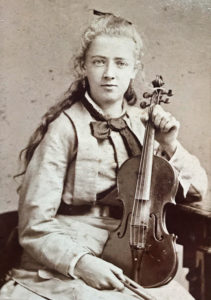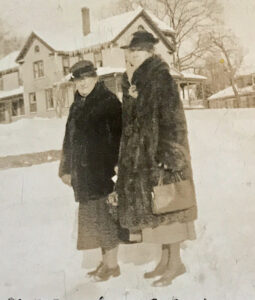True Tales from Canton’s Past: Sweetest Sounds
By George T. ComeauOn a quiet Sunday afternoon the sounds of Brahms would lift through the lazy air and people would gather on the sidewalk to listen. The music flowing from the small house at 847 Washington Street was indescribably beautiful. Inside the house Ms. Lillian Shattuck held the attention of her assembled guests. For anyone who heard the music, they could never forget the delicate and precise notes that flowed together in unison to produce poetry. And, for any passerby that heard the music, they never realized that it came from someone who was a trailblazing influence in music history.

Lillian B. Shattuck at age 17 in a photo taken at the time she graduated from Canton High School (Courtesy of the Canton Historical Society)
In our midst, here in Canton was one of the finest violinists in the world. And, in her day, Lillian Shattuck was a groundbreaking pioneer who created and nurtured hundreds of women who would break the barriers of misogyny and take their place in the world of music alongside men.
The daughter of William Shattuck and Mary Billings, Lillian Shattuck was born Elizabeth Bradley Shattuck in Canton in 1857. The Shattuck family was firmly rooted in Massachusetts, having likely immigrated sometime prior to 1639. There is a memorial to the first of the Shattucks that reads, “To perpetuate the memory of WILLIAM SHATTUCK who died in Watertown Aug. 14, 1672, aged 50. The progenitor of the race that have borne his name in America. And of his son JOHN SHATTUCK who was drowned in Charlestown Ferry Sept. 14, 1675, aged 28. This simple memorial was erected in 1853 by LEMUEL SHATTUCK who holds in grateful veneration the puritan fathers of New England.”
Lillian grew up with a solid education. Her father was born in 1826 and was a Civil War veteran and most likely the foreman at the Kinsley Iron and Machine Works. (He was listed in the 1855 state census as a “forge man” and subsequently listed as a foreman thereafter.) Lillian’s mother was born in Canton in 1826 and came from a long line of Billings’ with a rich musical background. It is likely that Lillian’s earliest influences were rooted in the music that flowed through the family. Her great-grandfather and grandfather both played the violin and Lillian, at a very early age, would have shown an affinity for the instrument.
It seems foreign today to suggest that instruments were paired to either sex, but the violin was one such instrument, almost entirely relegated to men. One writer of the late 19th century wrote, “The picture of an angel fiddling a solo, be it ever so divinely, is an ideal incongruity, and invokes laughter.” At the time that Shattuck was born, a woman violinist was a rarity in Europe as well as America. Yet, by the time she graduated from Canton High School in 1874, there were two women at the highest pinnacles of music that played the violin. One was Czech-born and the other was a French-born named Camilla Urso. It is extremely likely that Shattuck had heard Urso play in Boston or Worcester. Whatever the case, Shattuck would take her place in the history of American music to become quite well known throughout Europe and the United States.
In the late 1800s the pay for a first-class violinist was quite good. A violinist in Boston could earn between $5,000 and $10,000 per year, which would be in excess of $100,000 in today’s terms. Women breaking into this field would certainly be paid less, but would be well compensated nonetheless. One man took on the task of encouraging women to play and to perform. That man was Julius Eichberg, who had emigrated from Germany to the United States about 1856. Eichberg eventually moved to Boston in 1858 where his brother was a merchant. Through the 1860s he composed comic operas and eventually was the concertmaster of the Boston Symphony. By 1868 Eichberg had become the director of the newly founded Boston Conservatory of Music and also the superintendent of musical instruction in the Boston Public Schools.
In December 1874, Eichberg presented a recital at the Boston Conservatory. The recital featured a work written by Eichberg and was performed by 24 violin students, 19 boys and five girls. This was the first public appearance of Lillian Shattuck, who would help form the nucleus of the first female string quartet in the United States. The Eichberg String Quartet would become a prominent feature throughout the concert halls in Canada and across America. In their second season of performances, Shattuck led the quartet to more than 215 concerts from Lake Superior to the Rockies.
Not all critics hailed the musical prowess of Shattuck and her fellow musicians. After a performance in 1878, an Evening Gazette review observed, “A violin seems an awkward instrument for a woman, who’s well-formed chin was designed by nature for other purposes than to pinch down this instrument into position. Nevertheless, we cheerfully bear witness that four bright damsels in a row, all the bowing with tune for precision, is an interesting and even pretty sight.” The New York Times and a paper in Philadelphia were kinder, but also foreshadowed the fight for the Women’s Suffragist movement. “We are glad to see one more avenue open to women … those who can solace themselves and others with music ought to be content, even though deprived of the vote.”

Lillian B. Shattuck and Jennie Daniell outside their home at 847 Washington Street, February 1938 (Courtesy of the Canton Historical Society)
In 1881, Eichberg sent the quartet to Berlin for a year of study, where they performed and received positive reviews by local newspapers. In an article titled “Lady Violinists,” Eichberg wrote, “We should be remiss in failing to credit our female students with at least an equal degree of talent, industry and success. We gladly espouse the cause of women’s right to play upon all the instruments of the orchestra.”
Despite criticism, the Eichberg Quartet broke boundaries through their precision and perfection. Shattuck was recognized as one of the finest female musicians in the world. Taking her cues from her own teacher, Shattuck herself became an instructor and role model. At first she began teaching at the Boston Conservatory of Music, but by 1895 she had opened her own violin school at the S.S. Pierce Building in Copley Square. From the fifth floor in room 54, Shattuck and her various musical partners taught hundreds upon hundreds of women the techniques of the violin and other string instruments. The music school ran from 1895 through 1936 and was a well-known institution in Boston musical circles.
In 1912, the largest orchestral concert ever given to that date in Canton was performed at Memorial Hall to benefit the erection of the Soldier’s Monument at Canton Corner. Forty stringed instruments and 10 soloists all played to a packed house. The event was a major attraction and Shattuck was able to play to her neighbors and friends as if she was in Salzburg. The event was a memorable fundraiser and a tribute to Shattuck’s ancestors who fought in the Civil War.
One of Canton’s local historians, Ed Bolster, noted in his reminiscences many years ago how as a child and living close by, he recalled with fondness Lillian Shattuck. “She crossed the Atlantic 44 times in her lifetime,” Bolster wrote. “Every summer she played at the Salzburg and Vienna music festivals. As a boy I remember the Sunday afternoon musicals. Many of Boston’s musical celebrities attended. Mr. Albert Spalding, famed violinist, attended, and during the break many were seen on the front lawn talking and smoking. After the break they would all go back to Brahms, Beethoven and Bach. The best part of this was the next day when Mary Flaherty, Miss Shattuck’s cook and maid, would be waiting for us to come home from school. She would have paper plates filled with all sort of goodies left over.”
When Shattuck died in 1940, she left four violins along with other instruments to her family. One of the violins, which once belonged to Shattuck’s great-grandfather, was left to a cousin on the Billings side, and a second that was owned by her grandfather was left to a second Billings family member. While never marrying, Shattuck had a close partnership with Jennie Daniell, who was by her side at the music school and lived in Canton with Shattuck. As a token of her affection for Daniell, Shattuck left her two violins — one was an 18th century violin made by Nicolò Amati and the second was made by Antonio Stradivari. Shattuck is buried at the Canton Corner Cemetery.
Short URL: https://www.thecantoncitizen.com/?p=66450










